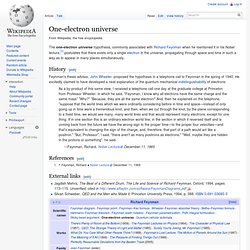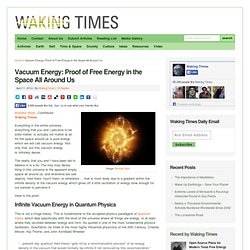

One-electron universe. The one-electron universe hypothesis, commonly associated with Richard Feynman when he mentioned it in his Nobel lecture,[1] postulates that there exists only a single electron in the universe, propagating through space and time in such a way as to appear in many places simultaneously.

History[edit] Feynman's thesis advisor, John Wheeler, proposed the hypothesis in a telephone call to Feynman in the spring of 1940. He excitedly claimed to have developed a neat explanation of the quantum mechanical indistinguishability of electrons: Vacuum Energy. Brandon West, ContributorWaking Times Everything in the entire universe, everything that you and I perceive to be solid matter, is actually not matter at all.

All the space around us is pure energy which we will call vacuum energy. Not only that, but this vacuum energy is infinitely dense. The reality that you and I have been led to believe in is a lie. The only truly dense thing in this universe is the apparent empty space all around us, and whenever we see objects, hold them, touch them, or otherwise … that is most likely due to a gradient within the infinite density of the vacuum energy which gives off a little oscillation of energy slow enough for our senses to perceive it. Amplituhedron. Artist’s rendering of the amplituhedron, a newly discovered mathematical object resembling a multifaceted jewel in higher dimensions.

Encoded in its volume are the most basic features of reality that can be calculated — the probabilities of outcomes of particle interactions.Illustration by Andy Gilmore That’s right ladies and gentlemen, quantum mechanics just got easier to understand. A team of physicists have released a paper showing their discovery of a jewel-like geometric structure that takes equations, which can be thousands of terms long, and simplifies them to a single term. This discovery is poised to dramatically simplify the equations particle physicists use when calculating particle interactions. It also proposes the uncomfortable idea that space and time are not fundamental aspects of our reality, and it brings us much closer to unifying gravity and quantum theory under one comprehensive model.